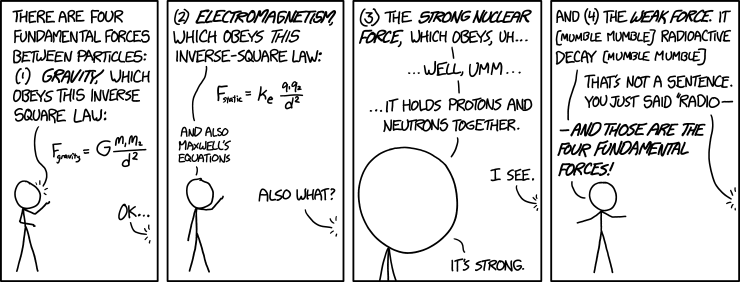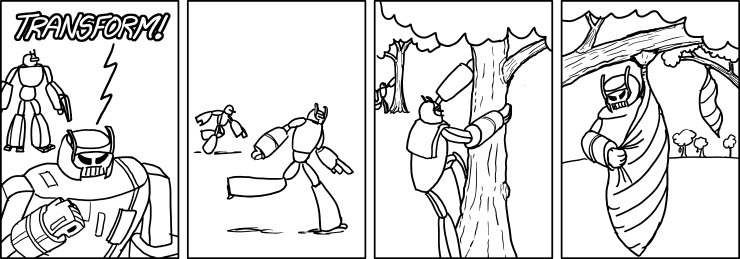
Shared posts
23 May 18:18
Adorable Pedal Cars
by Avi Abrams
 "QUANTUM SHOT" #896 "QUANTUM SHOT" #896 Link - article by Simon Rose and Avi Abrams Pedal Vehicles Showcase - Big Ideas in a Small World I guess the human fascination with cars, boats and planes could easily originate in our childhood and looking at some of these pedal vehicles, it’s hardly surprising. Some of these pedal cars are originals that have been restored, while others are modern reproductions, but they’re still pretty cool. So sit back, make yourself comfortable and enjoy the ride. 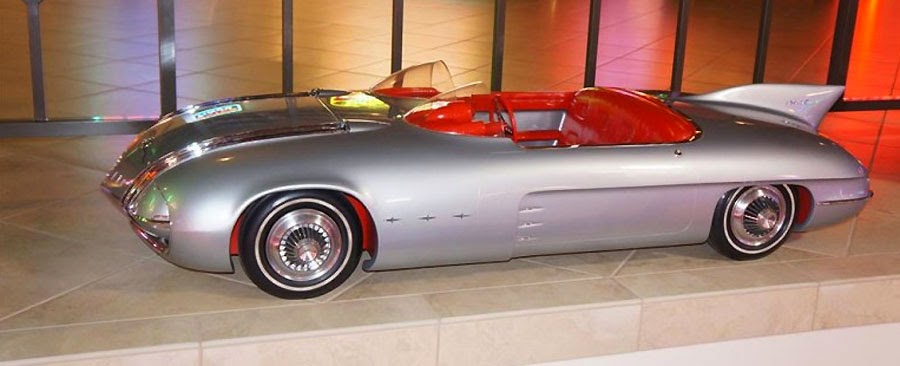 (1956 Pontiac Club de Mer pedal car, sold at Barrett-Jackson for $33,925.00, part of the The Pratte Collection) Pedal cars have been around almost as long as the automobile itself. In the United States, they were at their peak of popularity in the 1920s and 1930s, with kid’s pedal cars having many of the features, in terms of bodywork anyway, as the vehicles driven by their parents.   Here we see a proud father with his son’s first car (top right), well a pedal car anyway. We can also note that pedal cars weren’t just for boys, although all three of these young ladies (bottom right) look a little too big for this particular model. On the left image below is a 1934 Lincoln pedal car, while the Roadster on the right dates from 1941:  (images credit: California Auctioneers, MidAmerica Auctions) These are modern reproductions of pedal cars from the same era, which are available in different colours for the discerning young driver:  (image credit: Best Pedal Cars) These two pedal vehicles based on classic automobiles were apparently custom-made for a vintage car event in Pennsylvania a few years ago:  (images via) This one (left) is modeled on a Formula One racecar from the 1950s. The car on the right may be labeled as speedway pace, although I doubt if it’s capable of those kinds of a speeds. It probably wouldn’t be that safe to drive on the speedway track either:  (images credit: Liveauctioneers.com, The Antique Toy) Fifties style Ferrari F2 Grand Prix racecars were the inspiration for the pedal cars shown above. The left picture is an original, while the right car is a modern reproduction. Still, the driver in his shades looks pretty pleased with his gleaming chrome ride, doesn’t he? -  (images via 1, 2) This one on the left is based on the micro cars that were popular for a brief time in the 1950s and there’s even a full size Velam for a size comparison. Surprisingly perhaps, the Velam was capable of speeds in excess of 50 mph (80 km/h). In 1957, the street legal version of the Velam appeared in the movie Funny Face, which starred Audrey Hepburn and Fred Astaire. The pedal car on the right is a restored model from 1964:  (images credit: Jon Santarelli, Bruce Weiner Microcar Museum), 2 This one on the left has an interesting design, although it’s probably not originally from the golden age of jazz. And how about this hot rod pedal car on the right? Let’s just hope the driver doesn’t have a temper tantrum while in the driving seat:  (images via 1, 2) This is an unusual model on the left, based on the VW van that first appeared in the 1950s. Looking a little like a miniature VW Beetle, this pedal car (right), likely dating back to the seventies or early eighties, is called a Junior Sportster:  (images credit: Kevin, Vintage Children's Pedal Car) A very nice convertible model (left) from the seventies, in a colour guaranteed to get you noticed among your fellow pedal car drivers. Also from the 1970’s, the Elf Mobile on the right is thought to have been used for advertising displays in the grocery stores of that era:  (images via 1, 2) Here’s an Oscar Meyer Weinermobile pedal car, that’s not so much of a hot rod, more of a hot dog. This Coca Cola pedal car (right) serves a reminder of a time when the famous soft drink only cost five cents, which seems like a long time ago now:  (images via 1, 2) These two are both hot items, with those flames decorating the hood. Or maybe the engine was in danger of catching fire, if the car was going so fast? -  (images via 1, 2) Of course, if your engine did go up in flames, I guess you could always call on the fire department. Although perhaps in need of some restoration, this pedal car (left) would have been quite an expensive item back in the 1930s. Back then it was equipped with battery powered working headlights, as well as removable ladders, a movable gear shifter and the traditional fireman’s bell. The junior fire chief operating this one on the right could perhaps have used his ladders to deal with household hazards? -  (images credit: 1stdibs.com, Stagecoach Toys) This one from 1963 (right) is more of a sleek design. It even has a red light for clearing a path during emergencies, although I’m not sure if it was operational. This truck on the right is more modern, but still resembles earlier models:  (image via 1, 2) All pedal vehicles aren’t based on cars or trucks, of course. Planes, trains, automobiles and even tractors have all been used as models for pedal toys over the years. This Wooden Gendron Scout Pedal Plane from 1928 (left) certainly looks like it might have been a little chilly for the pilot, if it had ever actually taken to the air. Another red one on the right, this time based on the plane flown by the Red Baron himself, Manfred von Richthofen, the renowned German flying ace of World War I:  (images via 1, 2) The Steelcraft U.S. Army Patrol Plane from 1941 (left) was the inspiration for this more modern chrome pedal aircraft. Almost makes you want a full size working version, doesn’t it? This plane on the right has Army written beside the logo on its wings, so may have originated in the period before the U.S. Air Force was created in 1947:  (images via 1, 2) This restored Jolly Roger Pedal Boat (left) is from the 1950s, while the model on the right was manufactured between 1966 and 1968. Both vessels have battery-operated outboard motors, although I don’t think I’d recommend taking either one of them in the water:  (images via 1, 2) Here’s a vintage Murray Diesel 2 Ton Pedal Tractor (left), which perhaps couldn’t exactly be relied upon to pull anything quite that heavy. These days, there are certainly Thomas the Tank Engine pedal cars, among other train designs, to choose from, but models based on trains have been around for a while. This wooden one, complete with a bell for warning anyone in your path, dates from the early 1940s:  (images via 1, 2) Moskvitch-type pedal cars were very popular in the 1960s Soviet Russia, bringing tons of happiness to the kids of that generation:   (images via)  (images credit: Avi Abrams) Article by Simon Rose and Avi Abrams, Dark Roasted Blend. CONTINUE TO "VINTAGE CONSTRUCTION TOYS" -> ALSO READ: DRB VINTAGE CATEGORY ->
|
25 Apr 07:07

Tales: The Fall of the Drow

Travelling by night, our party of mid-level adventurers were passing through a mountain forest of tall dark pines that clustered thickly together. Snow was on the ground and there was no moon. The sky was clear and full of stars, looking down on our progress as we trudged over the crunchy…
Read more
Hpmcwill likes this
12 Sep 21:48
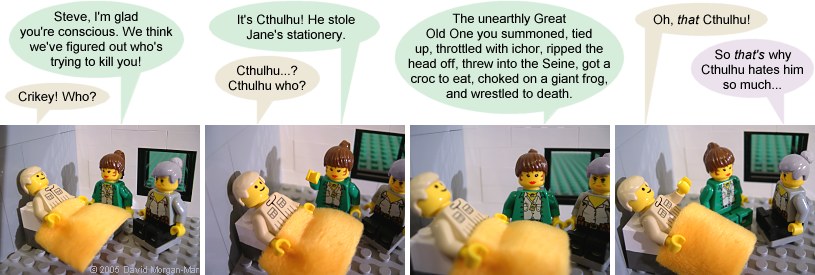
2014-09-12 Rerun commentary: Yeah, because if there's anything that annoys an unspeakable ultradimensional entity, it's not being remembered.
Irregular Webcomic! #899 Rerun

Summoned, tied up, throttled with ichor, ripped the head off, threw into the Seine, got a croc to eat, choked on a giant frog, and wrestled to death. And after all that, Steve still can't remember him.
2014-09-12 Rerun commentary: Yeah, because if there's anything that annoys an unspeakable ultradimensional entity, it's not being remembered.
Also, Steve appears to hate hospital gowns as much as I do.
09 Jan 19:32
American Supersonic Airliners: Race for a Dream
by Avi Abrams
 "QUANTUM SHOT" #189(rev) "QUANTUM SHOT" #189(rev)Link - article by Avi Abrams Boeing-2707 SST: a Supersonic Marvel, Largely Forgotten Today Capable of transporting 296 passengers across the ocean at 2900 km/h, developed 40 years ago, in 1968... The Sixties (or for that matter, the Fifties) were truly amazing years when it comes to development of fascinating - and often futuristic - technology. The automotive industry, for example, entertained public imagination with powerful full-size cars, a true embodiment of the "American dream" and sheer optimism of the times. In space exploration, we reached all the way to the Moon; in air travel, the dream of an American-made supersonic passenger plane seemed almost certain to become reality. Witness "Boeing-2707" SST (Supersonic Transport): a beautiful streamlined airplane, almost as big as a Jumbo jet and capable of Mach 3 speeds (much faster than the Concorde):   (top image via) America enters the race... achieves great results, and... well, let's just say it was good while it lasted It all started in 1952 with a small-scale study of the feasibility of SST designs by the Boeing company, and things heated up significantly when in 1962 the governments of Britain and France decided to join efforts in the creation of a supersonic Concorde airplane. Then the intrepid Russians also came up with the Tu-144 aircraft (which proved to be as capable as the Concorde, but, sadly, was plagued by accidents and grounded after only 55 passenger flights). The American government nearly panicked at this point (remembering all too well the embarrassment of the Cold War space race after the "Sputnik" launch) and quickly responded with its own program for Supersonic Commercial Air Transport (SCAT) development. The "SCAT" program got endorsement from President Kennedy himself in 1963 - and the race for dominating supersonic airways was "on".  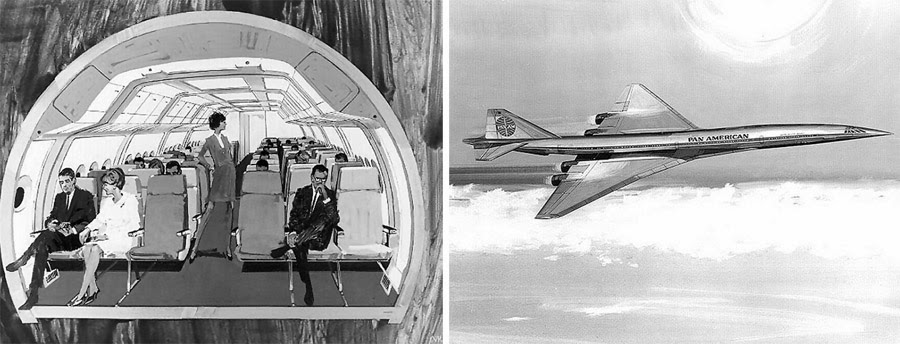 (images via) It's worth noting that back then it was widely believed that all future commercial aircraft would be supersonic (which just shows how futuristically-inclined general thinking was in the 1960s). The goal was to produce a commercial aircraft capable of carrying at least 250 passengers (twice as many as the Concorde) at Mach 3 speed, with a Transatlantic range of 4,000 miles. Such was the dream... loftier than the competing European projects, perhaps even as glorious as the idea of reaching the Moon. Development of Boeing 733: from a "delta wing" to a "swept wing" The proposed plane would be almost twice as large as the Concorde, will cost two times more (here is the seed of its eventual downfall!) and require twice as much time to build, but it would be the "American Dream" plane, the future of the world's airways (FAA estimated that five hundred of such airplanes will be in use by 1990):  (right image via) This picture clearly shows the proposed Boeing 2707 SST being at least as large as the Boeing 747 Jumbo jet, if not larger: 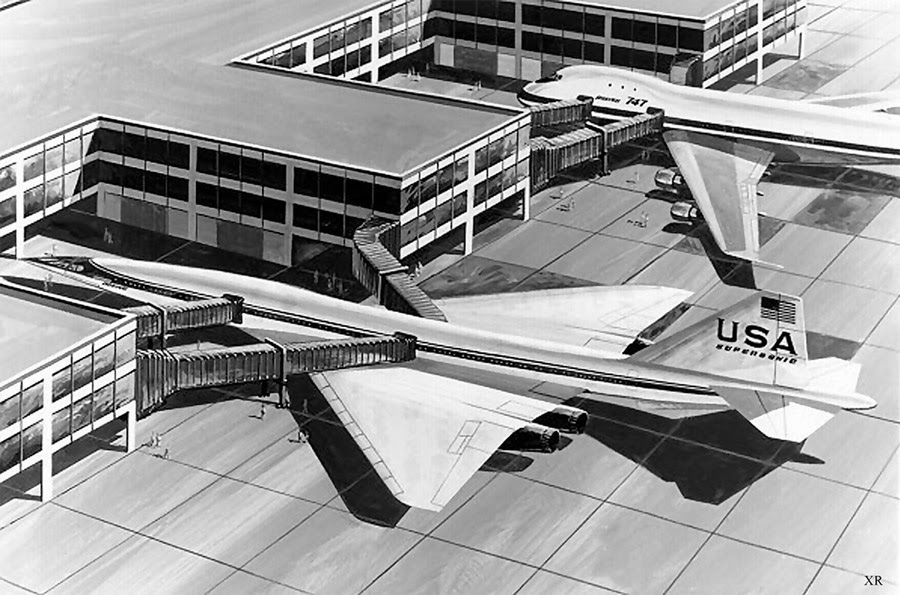 (image via) Here is the conceptual development of wing geometry (with variations on a delta-wing and a swing-wing theme); on the right is the air tunnel testing of a Boeing 733 model:  (images courtesy of NASA) The "variable wing" geometry has enjoyed quite a history in the US (read this article for example), plus considerable data has been accumulated by the military after developing the XB-70 "Valkyrie" strategic bomber and the YF-12 «Blackbird» spy plane. All of this gave enough reasons for American engineers to start boasting that European supersonic aircrafts were based on already nearly obsolete technology - and while American planes may not enter production first, they most certainly will end up to be the best!  (The McDonnell-Douglas SST proposal in 1966; image via) Some of these concepts looked like the F-111 fighters with a "variable geometry" wings added on (perhaps a legacy from the TFX program), and others could pass for a Rockwell B-1 bomber prototype. However, even while Boeing was clearly making some progress, it did not enjoy a monopoly on SST research for long. In 1964 the government admitted "Lockheed" into preliminary design competition - while "North American" (responsible for the development of the X-15 Rocketplane) was strangely declined. Thus, two giant corporations ended up pitched against each other, and the race for the winning design again nicely heated up. An honorable mention: Lockheed 2000 This baby was admirably full-size, boasting good lines and very healthy stats: some models could transport up to 300 passengers with a range of 3500 miles. The Lockheed mock-up was proudly presented to the judges in 1966, but the rival Boeing-2707-100 was already in the works, capable of taking that many passengers and more, plus featuring better aerodynamics and less noise pollution. Not surprisingly, Boeing emerged the sole winner of the government contract. 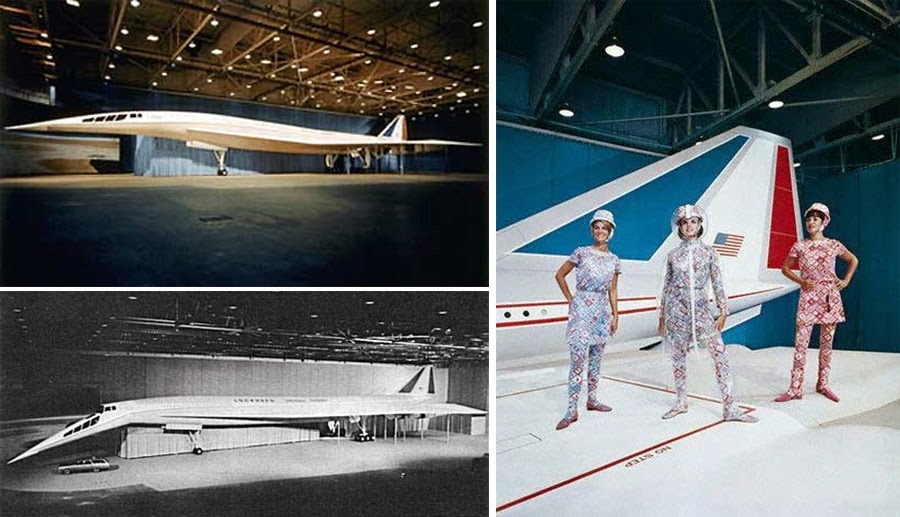 (images courtesy of Lockheed) Note: spacesuit-like helmets on cute stewardesses were all the rage in 1960s, in case you did not know. See our previous article Glamour in the Skies for more of the Braniff Airlines helmeted uniforms, designed by Emilio Pucci. Boeing 2707-100: growing longer and sleeker... With engines now in the tail section (removed from under the fuselage due to safety concerns), "Boeing 2707" retained the variable geometry wing configuration and a distinctive two-hinged "droop-nose" - added to impove visibility during takeoffs and landings. A new name also reflected the fact that the plane's speed was now an impressive Mach 2.7.   Boeing 2707-200: almost there! New 2707 model proclaimed return to a tailed delta wing - ironically, the very same configuration of a rejected Lockheed entry. By October 1968 it was decided to abandon the variable geometry wing idea due to overwhelming technical difficulties. However, the 2707-200 again grew in size, reaching (some say) truly monstrous proportions. While such size is obviously not practical, to me it looks more like a futuristic "dream come true":   (The Delta Airlines "swing wing" 2707 designs; bottom right model by John Meyer) Here is the size comparison:  (left image credit: Boeing) Boeing 2707-300: already 2 years behind schedule... a prototype that never flew The new design was now smaller, seating "only" 234. Two prototypes were approved by President Nixon in 1969, as it was a widespread belief that SST aircraft would soon dominate the skies, rendering all other subsonic aircraft obsolete. 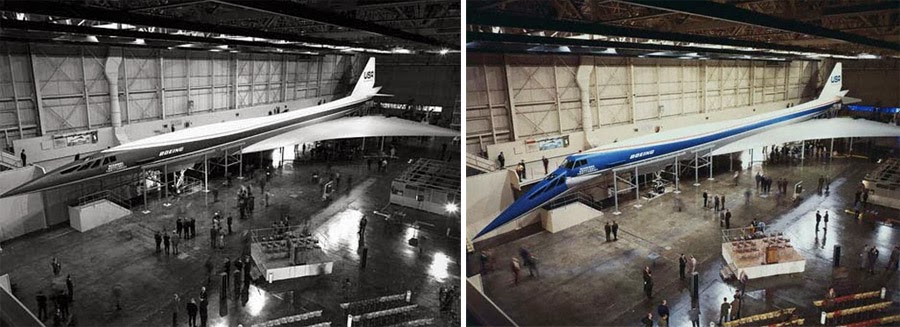 (images credit: Hiller Aviation Museum) Length: 306 ft (1968) 318 ft (1972) Wingspan: (1968) 174 ft extended 106 ft swept Cruising speed: Mach 2.7 or 1,800 mph Weight: (1968) 675,000 lb Passengers: 300 Altitude: More than 60,000 feet Power: Four GE4 turbojets Range: Transpacific, 4,000 mi   (photos courtesy: Ben Wang via Airliners.net) Soon, however, the all-too-smooth-going project began to gather adverse publicity. The biggest complaint was the environmental "noise pollution" issue, particularly the inevitable sonic booms and a possible reduction of the ozone layer. These concerns (perhaps not surprisingly) gained a lot of weight in the government, with the result being the complete ban on supersonic flights overland in the United States. Another troubling fact was discovered: at speeds above Mach 2.2 the aircraft would encounter so-called "skin friction effect" and its body will have to be built completely from either stainless steel or titanium, significantly increasing the price. The government (dogged on all sides and troubled by the Vietnam war) decided not to spend additional millions of dollars and completely cut the funding in 1971. According to Wikipedia: "The SST became known as "the airplane that almost ate Seattle." Boeing was a major economic force in the region, and was stretched so thin that a billboard was erected that read, "Will the last person leaving Seattle - turn out the lights?" "The High-Speed Research (HSR)" program was also canceled by NASA in 1999:  (image credit: NASA) Extreme costs in operating these glamorous supersonics brought the whole SST idea to an unfortunate end: the beautiful Concorde now resides in a museum, and the skies are dominated by sluggish, but fuel-efficient subsonic jets. The dream remains just a dream, for now... but consider one interesting fact: when government withdrew the funds for SST program, the money (over a million dollars) started pouring in from... American schools & kid's donations. Sadly, children's enthusiasm alone could not save the project.  ("Concorde" resides in a museum; appropriately, in Seattle) By the way, one of the most glamorous flights of the French Concorde was during the full solar eclipse in 1973 - as a flying scientific laboratory. This page has a few more pictures.  (image credit: NASA) But it's not the end of the story: meanwhile, in the remote & mysterious Russia... The new and improved TU-444 keeps the dream alive, and then some! The Tu-144 was the first commercial SST aircraft flown (built almost entirely on KGB money & Soviet military technology). It was withdrawn after a short time due to crashes and problems, but not before motivating Europeans and Americans to accelerate their own projects. With its successor, the Tu-444, the Tupolev Aircraft Design Bureau seems determined to keep the project alive and, perhaps one day, we will see these plans result in next-generation Supersonic Transport (which will not be plagued by problems and accidents).   (images credit: Tupolev.ru) Some say that modern travelers can get anywhere on the planet within 24 hours anyway, so it is kinda pointless trying to improve flight times with expensive SST fleet - but no, people at Tupolev's Design Bureau apparently got pretty excited by the idea of getting from Moscow to New York - and back! - within a day:  An update from 2012 on the status of this project shows insufficient funds and lack of interest from the Russian government. Thus, sadly, even though the dream itself lives on, the times when governments raced each other to realize a shared dream, are clearly over. Article by Avi Abrams, Dark Roasted Blend. Sources and further reading: Tupolev.ru, Hiller Aviation Museum, Testpilot.ru, Boeing, Global Security Military site CONTINUE TO "FUTURISTIC AIRCRAFT UPDATE" -> READ THE REST OF "AMAZING AIRPLANES" CATEGORY ->
|
25 Nov 20:09
Incredible Balancing Acts & Tightrope Walking
by Avi Abrams
 "QUANTUM SHOT" #857 "QUANTUM SHOT" #857 Link - article by Avi Abrams Up on the Roof: Not for the Faint of Heart If you've seen Harold Lloyd's classic comedy "Safety Last", you may remember his daredevil stunts of dangling from skyscraper clock's minute hand at a dizzying height and generally climbing without any significant support, producing huge thrills and frights. Today we are going to see more vintage and modern examples of such mind-bending balance, done for the camera (without any computer and special effects):  (man balancing on a piece of wood on the roof of a skyscraper 1939 (some say, Harold Lloyd himself?), photo via) Here is another twist on this dangerous "game of chairs", all performed in the 1920s-1930s:  (images via) American equilibrist J. Reynolds, performing acrobatic and balancing acts on high cornice above 9th Street N.W." in 1917:  (left image via) Another insane chair balancing stunt was recently performed by French equilibrist Henri Rechatin in Moscow, overlooking the Red Square - see video here:  (images via) Here is another balancing act involving chairs, this time performed by Chinese acrobats:  (image credit: Henry Atkinson) And finally, here is an insane acrobat performance on a ledge of the Empire State Building, photographed by Otto Bettman in 1934:  (image via) ------- These are fabricated balancing situations - created by Chinese artist Li Wei:  (images via) "Li Wei states that these images are not computer montages, but that he uses mirrors, metal wires, scaffolding and acrobatics".  (images via) ------- Extreme Heights Tightrope Walking Feats The following beautiful, atmospheric image was captured by French photographer Sylvain Emmanuel Prieur:  (image credit: Sylvain Emmanuel Prieur, via) Extreme slackline walking in Austria, by the Australian daredevil Michael Kemeter:  (image via) Not tightroping, but a BASE jumping platform using a vertigo-inducing suspended bridge in Gimmelwald, Switzerland:  (images via) And then, there is a newly popular activity among photographers and urban explorers: rooftopping. One of the masters of this extreme approach to photography is Tom Ryaboi (see more of his work here):  (images credit: Tom Ryaboi) ------- "All in a Day's Work" Balancing This kind of maintenance requires great balancing skills and no fear of heights: 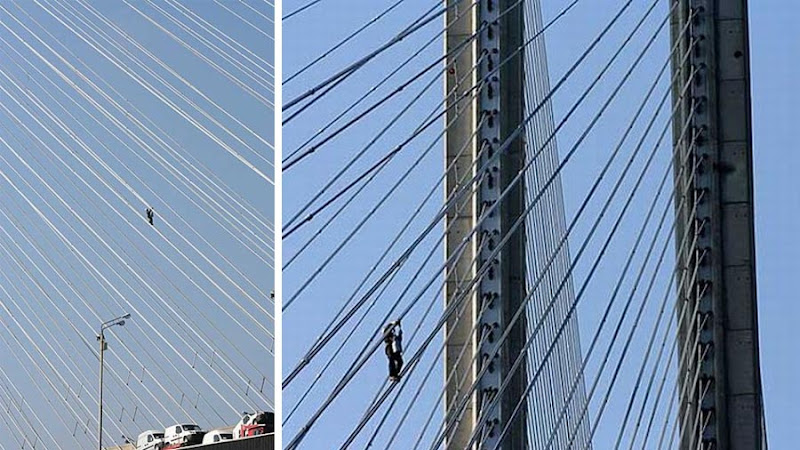 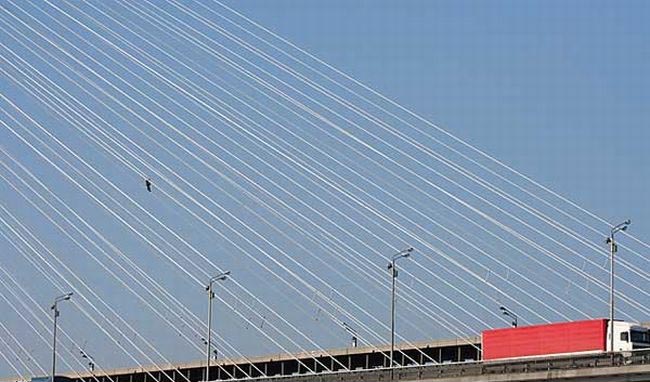 More "balancing during construction" madness:     Looks like this man is doing something wrong:  People in Sri Lanka mastered a very special "Balancing Act" for simple fishing purposes:  (image credit: Exodus.co.uk) CONTINUE TO OUR "EXTREME WEIRD" CATEGORY ->
|
30 May 18:37
05/17/13 PHD comic: 'A Professor's Prayer'
| Piled Higher & Deeper by Jorge Cham |
www.phdcomics.com
|
|
 |
||
|
title:
"A Professor's Prayer" - originally published
5/17/2013
For the latest news in PHD Comics, CLICK HERE! |
||
30 May 18:36
05/29/13 PHD comic: '(More) Great Tweets of Science'
| Piled Higher & Deeper by Jorge Cham |
www.phdcomics.com
|
|
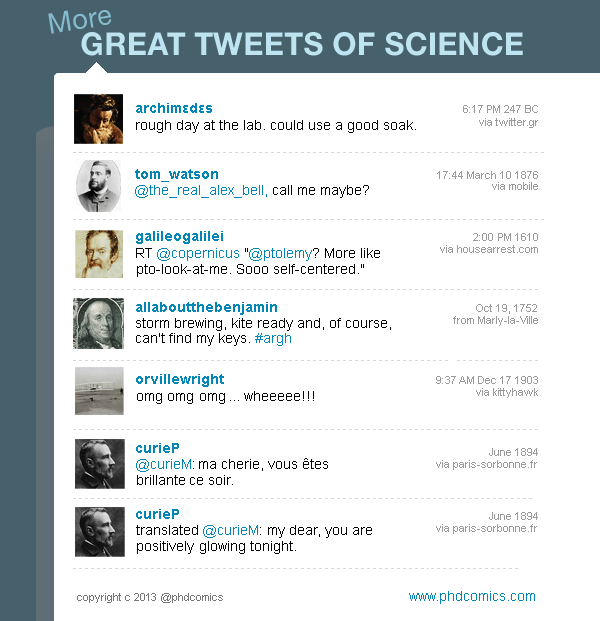 |
||
|
title:
"(More) Great Tweets of Science" - originally published
5/29/2013
For the latest news in PHD Comics, CLICK HERE! |
||
Trisha.gao, Hipstor and one other like this
28 May 11:10
The Cutest Animals: Awww Update
by Avi Abrams
 "QUANTUM SHOT" #833 "QUANTUM SHOT" #833 Link - by Avi Abrams In our rough and tough world we need a shot of cuteness from time to time. Well, then, consider yourself "shot". We featured some of the cutest animals in our previous posts (see our extensive "Animals" category). What can we say? It's time for another update! Latte, Capuchino, Caramel Macchiato & Espresso... guinea pig babies: 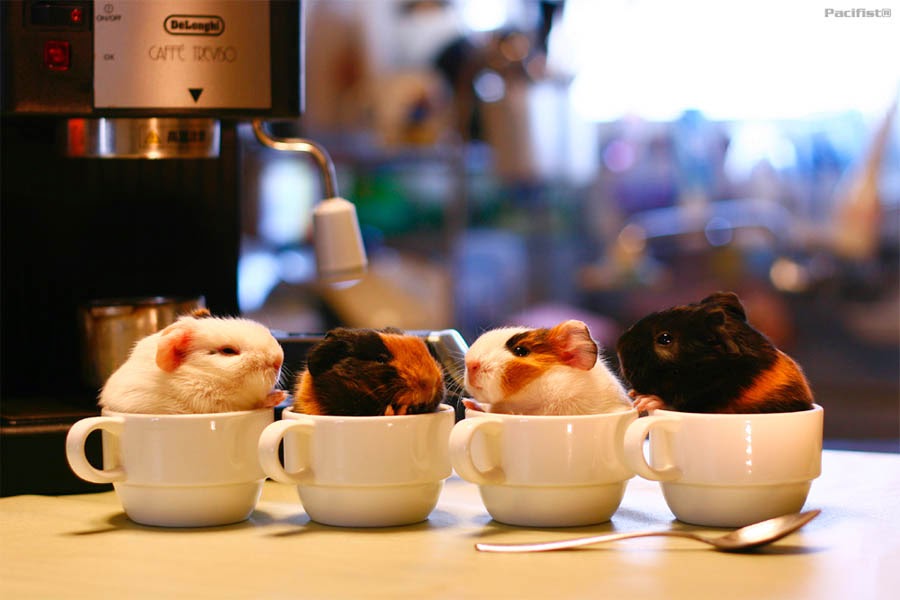 (image credit: Pacifist) What is it, with hamsters and flowers? - this little guy simply LOVES flowers:  (image credit: HendonGirl) Hold on a minute... I gotta warm my tummy - 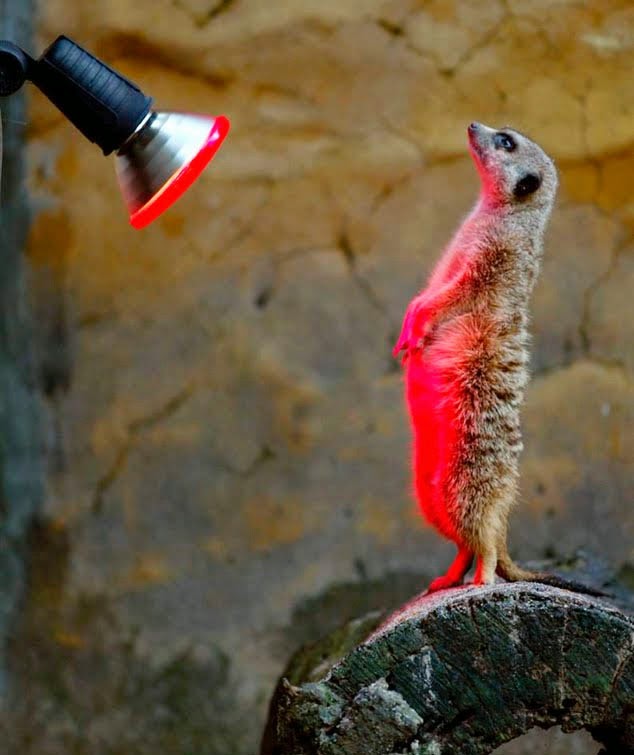 (this meerkat likes it - image via) Touch it! -   (images via) This photo is not simply an "awww" moment, it is also an elegant piece of art, worthy of framing:  (image credit: Fernando Amutio) This is a Golden Brushtail Possum This Trichosurus vulpecula Golden Brushtail Possum baby is called Bailey (his cream-colored fur reminds us of a certain Irish liquor) - these animals are rarely seen the wild, being a nocturnal marsupials mostly found in Tasmania:  (image credit: WILD LIFE Sydney) This is a Solenodon Sole... what? (the name means "Slotted Tooth"). This is a pretty rare nocturnal animal, which digs holes, eats insects and is venomous. It is interesting because it still retains unique characteristics of primitive mammals, which lived during prehistoric times - more info.  (image via) The Japanese dwarf flying squirrel is just as rare, and impossibly cute (check out these hazy, large eyes). Another very cute shot of resting squirrels is here.  (image via) This is a sloth; just one extremely grateful sloth. It was rescued in Costa Rica:  (image credit: Caroline Castendijk) A newborn Mongoose Lemur looks into the camera (right image)... Mongoose lemurs are very rare; their only protected habitat is the Ankarafantsika Reserve - they are the size of a small house cat and can be both diurnal and nocturnal (depending on the season):  (left image via; right image credit: Sacramento Zoo) 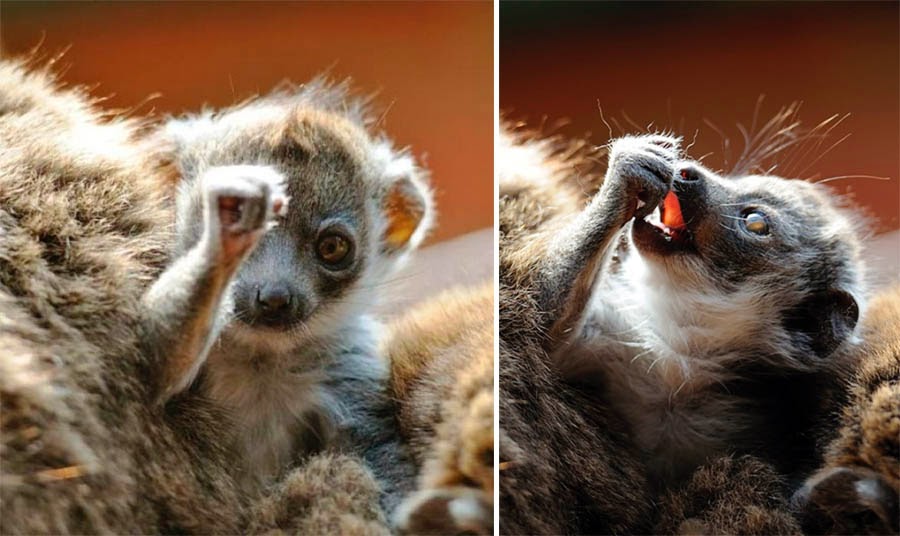 (images credit: Linton Zoo, Cambridgeshire) Here is a very cute, long-nosed baby meerkat (left image). On the right is another very sweet baby meerkat posing in rough:  (right image via) The long eared jerboa from Mongolia is on the left: 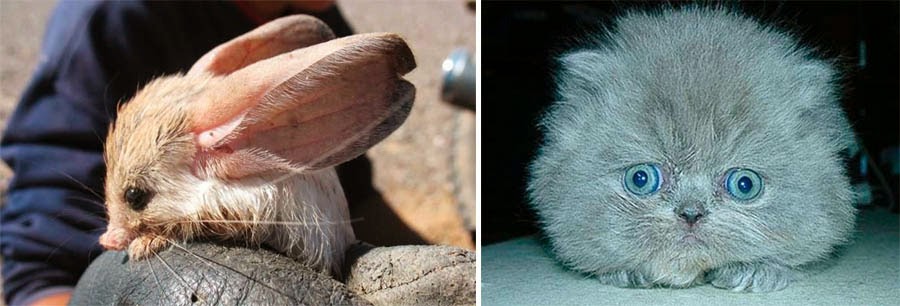 (originals unknown) So much tension! And excitement -  (bottom right image credit: Omar Alzaabi) On the right is a rare and wonderful Kinkajou seen at the Bronx Zoo:  (right image credit: Bronx Zoo, via) Time for bed; sweet dreams! - by the way, there is a whole book about this little rat, Bug, buy it here:  (image credit: Jessica Florence) This rat seems to like to go to bed with his plushy friend (just like Mister Bean does):  (image credit: Ellen van Deelen / SWNS.COM, via) Baby Pigmy Hippopotamus is having a bath (info) - 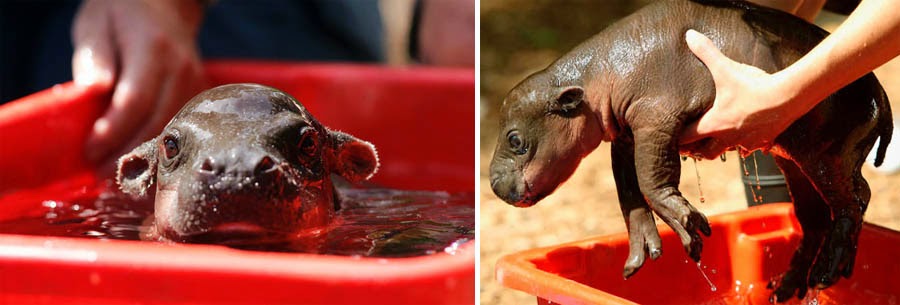 (image via) A marvelously cuddly baby Albino Koala:  (image via) Puppy Love? Sleeping cute puppy love, yes:    (images via 1, 2) White Fur Fuzziness Overload This is one sad owl... See a lot more adorable baby owls here. On the right is the bunny white "fur ball" -  (left image via; right image credit Francesca Birini) Here is a baby fennec fox (left), and a grown animal (on the right): these guys are sometimes called "little monsters", as they are very high maintenance and do not make good pets, no matter how cute they might look -  (images via) 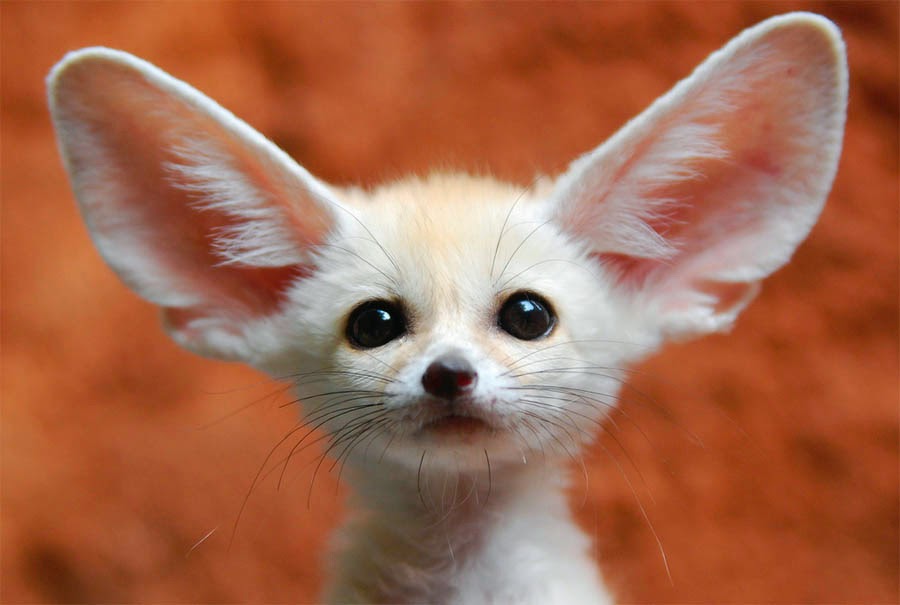 (image credit: In Cherl Kim) A baby otter can be utterly adorable as well: check out this "Otter Ball" -  (images via 1, 2) On the right, of course, is just a cute puppy.... But WHAT A CUTE PUPPY!! This is a bunny, right? -  (image via) Here is an African Pigmy Hedgehog with "flower power":  (image via) Here is a spineless hedgehog in a yellow jumper - and another story about a hedgehog with no bristles ("Betty the hedgehog, who was abandoned by her family because she does not have any spikes"):  (images via 1, ) "Staff at St. Tiggywinkles Wildlife Hospital in Buckinghamshire have made a little jumper to keep a spineless hedgehog warm. The animal was found by a member of the public in a garden in Bedford and has been named Spudlina by staff as her skin resembles that of a potato." And then, there is this baby chameleon: 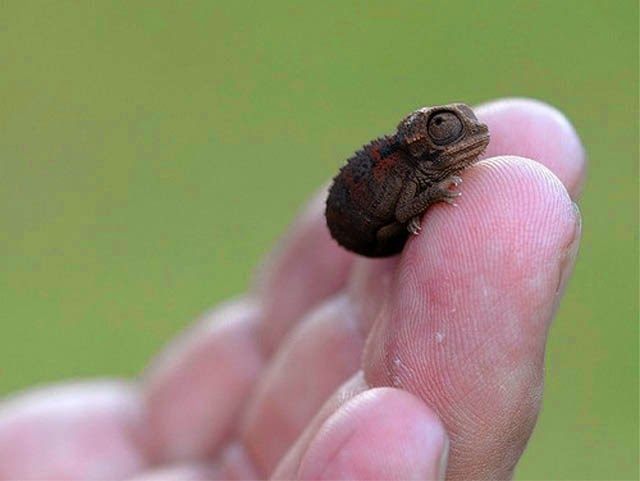 (original unknown) Interesting fact: "there are several species of pygmy leaf chameleons from Madagascar that are this size when fully grown." Check out the rest of our popular "ANIMALS" category ->
|
28 May 11:09
Topological Marvel: The Klein Bottle in Art
by Avi Abrams
 "QUANTUM SHOT" #834 "QUANTUM SHOT" #834 Link - article by Avi Abrams Impossible shape with no distinct "inside" or "outside" - in Art, Fashion and Architecture A geometric enigma, a convoluted mind-bender dropped upon us from the wonderful extra-dimensional realm of topology, the Klein Bottle is perhaps even more popular with artists and architects than the ubiquitous Moebius strip. In fact, the Klein Bottle is what happens when you merge two Moebius Strips together: the resulting shape will still have only one side - with its inside and outside merging into one! Such a paradoxical shape is clearly not possible within our three-dimensional reality and requires a fourth dimensional jump at some point to make it all come together. Also because true Klein bottles do not have discernible "inside" or "outside", they have ZERO VOLUME. As a result, these objects can only be simulated as an "impossible art" in our world, or only modeled with a "fake" 3-D intersection, instead of a true extra-dimensional joint. The more such intersections you add, the more it would look like some sort of a Spaghetti Monster:   (images credit: Torolf Sauerman, Bathsheba, Satgnu) On the left you see the intricate mathematical art by Anatoly Fomenko from Russia (Klein Bottle and Torus combination); on the right is a steam Klein Bottle cart "impossible concept" by Roger Shepard:  (images credit: Anatoly Fomenko, Roger Shepard) The first Klein Bottle was described by the German mathematician Felix Klein in 1882; here are his lecture notes (left image below). On the right is the famous Escher's Moebius Strip - a structure from which Klein Bottle can be formed by topological extension:  (images via 1, 2) And here is how the bottle can be formed (note: this requires an extra-dimensional jump at the "intersection", so it's only a simplified visualization):  Taking a clue from the Moebius strip image with ants crawling all over it (see above), this animation shows the path that these ants would follow crawling on the Klein bottle: 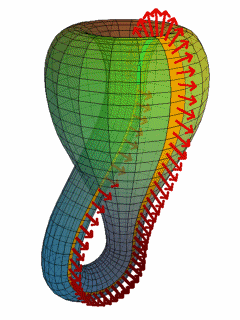 (image via) The Klein Bagel: do you want cream cheese with that? Also called "the figure 8 immersion of the Klein bottle" (read about immersions here), this bagel-like impossible shape has an even more impressive, impossible cross section:  (images via) This would be perhaps the first object that we'd print on a 3D printer The whole gallery of 3D models by Torolf Sauerman (also known as "jotero") is worth looking at (and drooling over the possibilities of 3D printing it for your office) - click here. He also runs a YouTube channel full of topological animations. 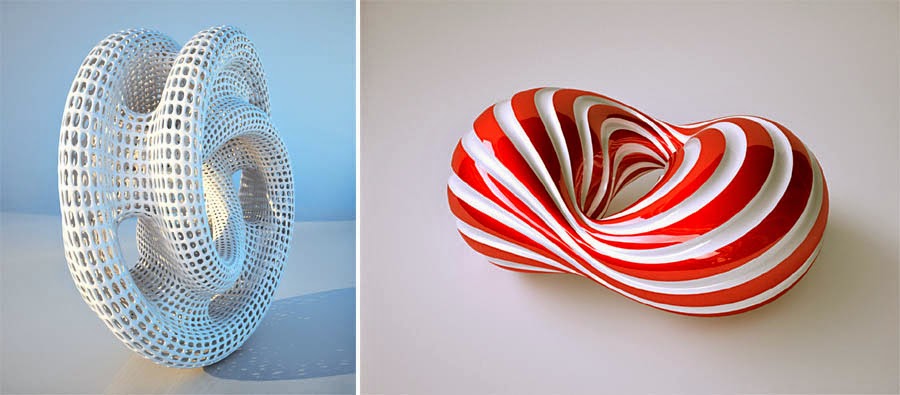 (images credit: Torolf Sauerman) Californian 3D artist Erik Anderson rendered this remarkably life-like image of chained Klein bottles: 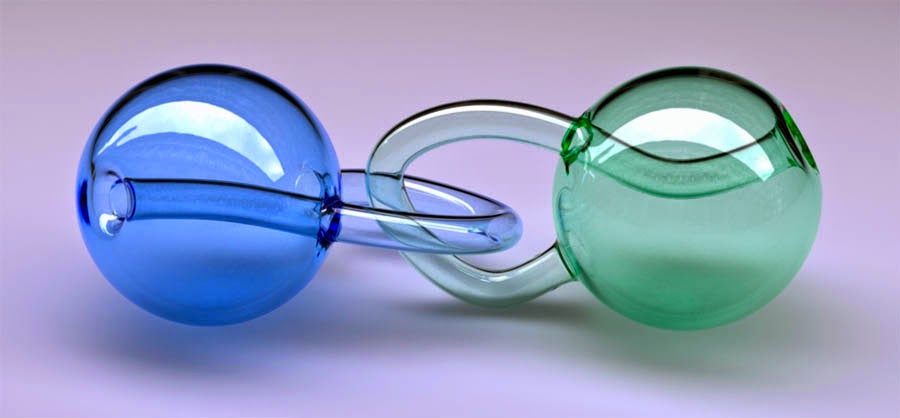 (image credit: Erik Anderson) Nested Topological Glass Vessels Here are a couple of rather more simplified, hand-blown glass emulations (the wine "glass" on the right you can even purchase here) -  (images credit: Clifford Stoll and Grand-Illusions, Encyclopædia Britannica) The California-based Acme Klein Bottle Company sports quite a catalog of different glass and plastic bottles. They describe their products as "the finest closed, non-orientable, boundary-free manifolds sold anywhere in our three spatial dimensions":  (image credit: Science Museum, London) Speaking about more sophisticated topological glass objects, you should check out glass Klein bottle collection on exhibit in The Science Museum in London - for example, this "triple bottle" variety (made by Alan Bennett in Bedford, United Kingdom, in 1995):  (image credit: Science Museum, London) Here is "a single surface, five-layered sphere: extension of the three Klein bottles above to infinity which when cut gives a pair of single-twist Moebius strips":  (image credit: Science Museum, London) Adding more and more rounds of "handles" that theoretically fold upon themselves, results in this intriguing glass sculpture: 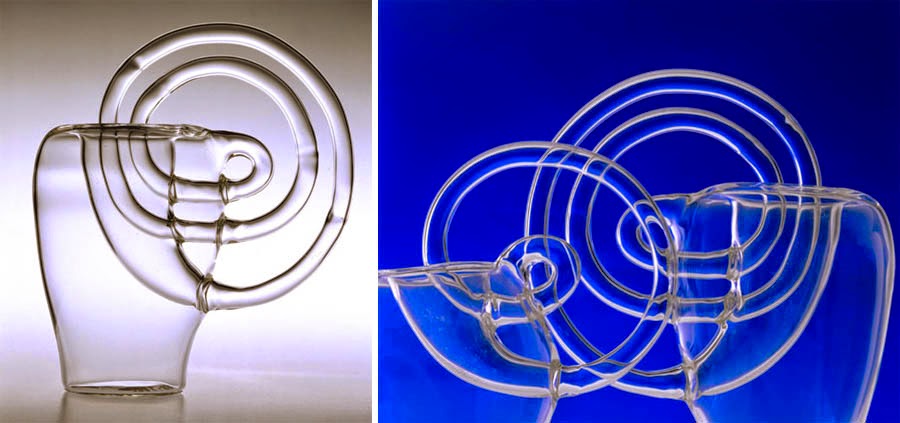 (image credit: http://www.sciencemuseum.org.uk/images/I065/10328081.aspx) These are the "two single surface glass vessels made by Alan Bennett in 1995. Part one is a double loop Klein bottle which when cut gives a pair of three-twist Moebius strips. Part two is a triple loop Klein bottle which when cut gives a pair of five-twist Mobeius strips." Do you want your Klein object DOUBLE, or TRIPLE? Produced by the same "Acme Klein Bottle Company", the double Klein bottle looks much like an hourglass - it was featured on the cover of the book, "Endless Universe" by Paul Steinhardt and Neil Turok. Both double and triple bottles are externally linked in this case, but it is also possible to link them internally.  (images via) In the middle you can see another Acme innovation - the spiral top vessel (more info). They also call it the "Spiral top Kleindensor" which are commonly used as condensors in 4-dimensional stills. On the right is the Acme Klein wine bottle, which might present a few problems in actual usage: "The Wine Bottle Klein Bottle is difficult to fill with wine, because of vapor-lock. As you pour water (or wine) into it, there's no place for the air to go. So the wine is trying to go down while the air is trying to go up the spout. Result is slow filling. Pouring wine out is equally frustrating. Not only are these difficult to fill and empty, but cleaning them is a real challenge. Since there's little air circulation within the Klein Bottle, moisture doesn't evaporate. Worse, you can't reach in with a towel. So you'll need to dry the interior surface using alcohol. I've had good luck with a pair of small magnets wrapped in cotton cloth." ... or, perhaps, even TRIANGULAR? Triangular, triple Klein bottle form:  (image via) Would you prefer your Klein manifold sliced? (more info):  (images credit: Science Museum, London, Klein Bottle) Stained Glass Impossibility This wonderful structure is made from 11 faces of brightly colored and illuminated glass, which certainly creates the illusion of complexity in its reflections; a sort of the stained glass 3D puzzle. it was created by glass sculptor Istvan from Hungary:  (image credit: Istvan) Klein Bottles in Architecture: A Klein Bottle House Remember a great 1940s science fiction story by Robert A. Heinlein "And He Built a Crooked House"? The bizarre topological house featured there was a tesseract, but a Klein bottle would lead to similar fantastical adventures if one were to get stranded inside of it by some freak accident: 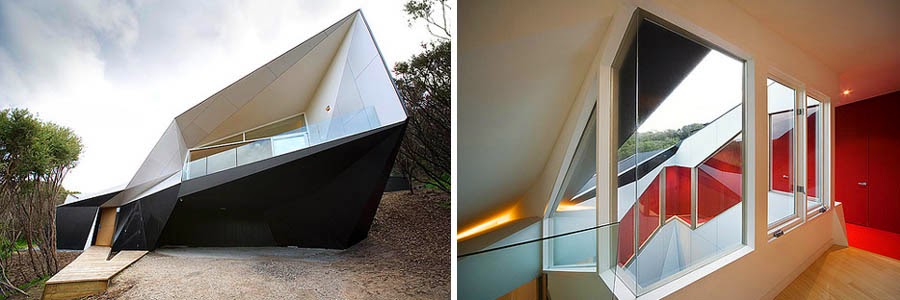 (photo by John Gollings, via) The Klein Bottle House was built by architects McBride Charles Ryan just outside Melbourne, Australia, has all the trappings of a science fictional dwelling and mathematical Garden of Eden for those who like their brains and sense of orientation challenged - but it also looks surprisingly liveable and warm (more info). The Klein Bottle Playgrounds: Just don't end up with arms and legs tied in a topological knot! How do you build physically impossible structure, especially turning it into a playground? Well, you could use the so-called "figure 8 immersion" of Klein Bottle: American artist, designer and architect Vito Acconci has been commissioned to create such an intriguing shape as part of a playground in the Miami Design District in 2014  (image credit: Vito Acconci) On the right image above you can see another mind-boggling park installation by Vito Acconci, perhaps even more sophisticated and original.  (image via) Here is a Krabbelknoten , a crawl-through playground structure installed at the ‘Math Adventure Land’ in Dresden in 2011 - more info  (images via) Sophisticated mathematical knots make up great knitting projects! Check out these single-sided Klein Bottle Hats (created by Kleinbottle and Majolo):  (images via) Klein Bottle Bottle Opener and Coffee Cups I wonder if you open a wine bottle with a physically impossible bottle opener (made by Bathsheba Grossman), would that lead to some miracle while drinking the wine? Perhaps the wine would never run out? I can only dream.  (images via 1, 2) Similarly, impossible topological coffee cups should lead to a never-ending supply of coffee inside (siphoned from some helpless extra-dimension, straight into our coffee-starved reality). The cups on the right were made by Cunicode, a design agency in Barcelona, which came up with a unique cup for each day (a new coffee cup design every 24 hours); see lots of them at this link. Fold it!... and don't let it fall into an extra-dimensional wormhole - A single sheet of paper with no cuts or tape can be folded into this interlocking model of Klein Bottle: the crease patterns are available here. Dr. Robert Lang is responsible for this puzzling origami masterpiece:  (image via) Hide the M&M candy inside a topological machine, and kids would never get to forbidden sweets As we said before, Klein bottles are supposed to have zero volume, yet you can apparently fill them with M&M candy? Well, this standard Acme bottom-mouth Klein Bottle does the trick:  (images via 1, 2) Right image above shows the BIGGEST Klein bottle in existence: 1.1 meter tall, 50 cm diameter (the size of a 5 year old child) - made by the same Acme Klein Bottle Company. Here is the Klein Bottle - SQUARED! if you thought that simple Klein Bottle was something challenging to wrap your brains around, try this topological maze, created solely to befuddle our spatial 3-dimensional senses:  (image credit: Sea Moon) And now, to cool your brain after all these impossible topological exercises, here is a picture a NORMAL BOTTLE, with normal "inside" and "outside", for a change! -  (image credit: Bree Walk) Article by Avi Abrams, Dark Roasted Blend. CONTINUE TO "KILLER VIRUSES GLASS ART"! -> Check out the rest of our popular "ART" category ->
|










![We all remember those famous first words spoken by an astronaut on the surface of Mars: "That's one small step fo- HOLY SHIT LOOK OUT IT'S GOT SOME KIND OF DRILL! Get back to the ... [unintelligible] ... [signal lost]" We all remember those famous first words spoken by an astronaut on the surface of Mars: "That's one small step fo- HOLY SHIT LOOK OUT IT'S GOT SOME KIND OF DRILL! Get back to the ... [unintelligible] ... [signal lost]"](http://imgs.xkcd.com/comics/opportunity.png)
